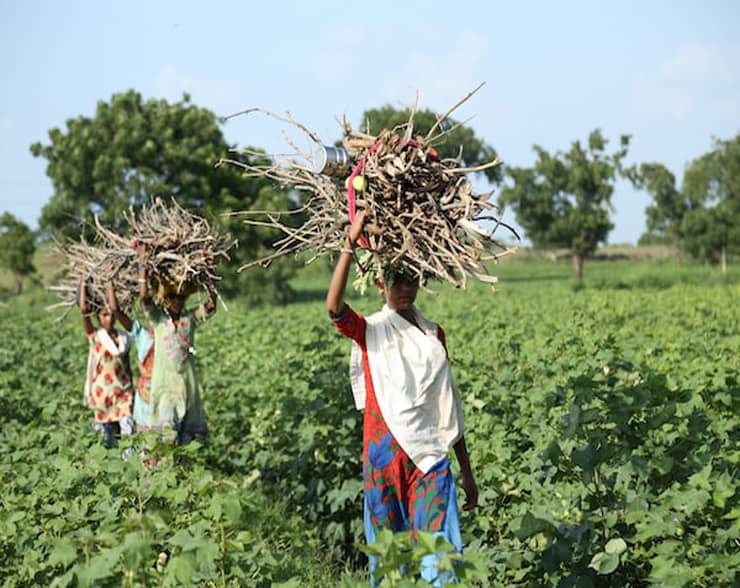 Appeals
Appeals
Day of Rural Women.
Featured Image: Photo by Gyan Shahane on Unsplash.
15 October is the United Nations-designated International Day of Rural Women. It is a day to highlight the critical role that women play in the food chain: in production, storage, marketing, and finally the preparation of food for the family.
Image: Photo by Brandi Alexandra on Unsplash.
The United Nations as One.
As the Indian woman sociologist, Bina Agarwal, has written.
«The typical rural woman works twelve to fifteen hours a day – gathering firewood and water, growing food, collecting fodder and tending domestic animals, cooking, cleaning and caring for children and the sick or elderly. In severely deforested areas, it may take her four or five hours just to gather enough wood to cook the evening meal.»
Thus rural women’s roles as managers of their environment and providers for their family must be fully recognized, valued, and supported. Increasing women’s access to income, credit, land titles and other resources is essential to eradicating poverty and improving welfare.
However, in many parts of the world, the basic rural biological systems – forests, grasslands, croplands, and rivers are deteriorating due to a variety of factors: population pressure, overuse, excessive production for export, and pollution. The causes for this deterioration will vary from one micro-region to another.

Bina Agarwal, receiving a Balzan Prize on 17 November 2017, in Bern (Switzerland). By Peter Mosimann, CC BY-SA 4.0 <https://creativecommons.org/licenses/by-sa/4.0>, via Wikimedia Commons.
Promoting gender equality is an important aspect of a development strategy that seeks to enable all people.
Therefore, it is important to look at some of the blocks and drawbacks that prevent better food production and to analyse the persistent inequalities and discrimination that women face at the village level. Promoting gender equality is an important aspect of a development strategy that seeks to enable all people – women and men alike – to improve their standard of living.
Modification of age-old patterns of agriculture, forest management, and the herding of animals is difficult. Changes to meet larger populations and to prevent harmful uses of land takes time and skilful education methods. There is a need to present information in ways that people can use in as short a time as possible. Education must be coupled with ways of organizing for community cooperation and participation in decision-making.
Today, half of the world’s population live in cities and larger towns (25,000 or more).
Rural aspirations are also expressed in mobility. Throughout the world, there is migration from rural areas to cities and larger towns. Will these rural hopes be channelled into creative social transformation or will rural migrants swell the slums and shantytowns there to dwell in despair? What has been the experiences to prepare rural youth for urban life and to help return of youth from urban to rural areas?
Today, half of the world’s population live in cities and larger towns (25,000 or more) The movement of people from the countryside into cities is a demographic trend that is likely to continue into the future. As a result, the rural areas of a country are often not a high political prioroty, and rural women even less. Thus the International Day of Rural Women should be a time to consider in depth the challenges facing rural women and the ways to meet these challenges.
René Wadlow, President, Association of World Citizens.

Presidente, Asociación de World Citizens (AWC).
Cursó Estudios de Relaciones Internacionales en La Universidad de Chicago.
Cursó Estudios en el Programa Especial de Civilización Europea en
La Universidad de Princeton
Here are other publications that may be of interest to you.
Prevenir la expansión del conflicto de Gaza: ¿Son posibles las brigadas de paz?
Antony Blinken, el secretario de Estado de Estados Unidos, ha estado nuevamente en Medio Oriente trabajando para evitar que la violencia de la Franja de Gaza se extienda a gran…
Ciudadanos del Mundo Piden un fin Inmediato a las hostilidades entre Israel y Hamás, y por un esfuerzo auténtico de construcción de Paz en Oriente Medio.
Imagen destacada: El impacto del bombardeo israelí sobre un edificio civil en Gaza (2021). Por Osama Eid, CC BY-SA 3.0 https://creativecommons.org/licenses/by-sa/3.0, via Wikimedia Commons. La Asociación de Ciudadanos del Mundo,…
Transformación del Populismo en Europa y las Américas: Historia y Tendencias Recientes.
Imagen de portada: Caricatura de juez de 1896 que muestra a William Jennings Bryan/Populismo como una serpiente que se traga a la mula que representa al Partido Demócrata. Por la…
Día Internacional de los Océanos.
Imagen destacada: Foto de Marek Okon, Unsplash. Es necesario avanzar en las delimitaciones marítimas asiáticas. . El 8 de junio ha sido designado por la Asamblea General de las Naciones Unidas como…
Siria: El Comienzo de una noche de dolor.
Featured Image: Photo by Ahmed akacha: https://www.pexels.com/es-es/foto/gente-demostracion-rally-protesta-7183546/ Por Rene Wadlow. El 13 de marzo de 2011 en Derra, en el sur de Siria, 15 adolescentes fueron arrestados por la policía…
Yemen: Aún se necesita Acción Positiva.
Imagen destacada: El Reino Unido acogió la reunión de Amigos de Yemen el 27 de septiembre de 2012 en Nueva York junto con los coanfitriones del Reino de Arabia Saudita…
Medidas para crear Confianza en Asia-Pacífico: Revertir la Deslizamiento hacia la Violencia.
Imagen destacada: Foto de wu yi, Unsplash Con los militares estadounidenses y chinos comprometidos cerca de Taiwan, un error de cálculo podría conducir a la violencia armada. El conflicto armado en…
Enfoque de la ONU sobre las consecuencias del Cambio Climático.
Imagen destacada: Foto por William Bossen, Unsplash El 20 de marzo de 2023, el Panel Intergubernamental sobre el Cambio Climático (IPCC) publicó un Informe de síntesis basado en sus tres informes…
Medidas efectivas para proteger nuestros océanos
Imagen destacada: Foto por Dave Hoefler, Unsplash. El 4 de marzo de 2023, en las Naciones Unidas en Nueva York, se dio un paso importante hacia la protección de los océanos…
Ruido de Sables en el Mar de China Meridional.
Imagen destacada: El USS John S. McCain realiza una patrulla de rutina en el Mar de China Meridional, el 22 de enero de 2017. El destructor de misiles guiados apoya…










